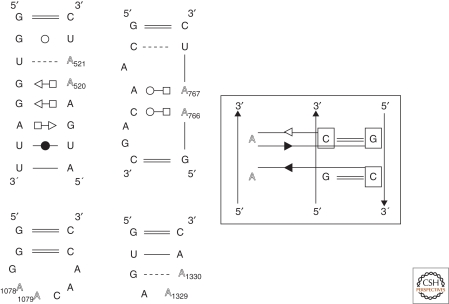Figure 2.
The figure shows four examples of A-minor interactions (the A residues involved are shown in gray tone). Notice how, despite the similar types of contacts, the two consecutive adenines can belong to very different local environments. At the left, four different types of motifs in which two consecutive adenines form similar types of A-minor interactions (Nissen et al. 2001) with two consecutive base pairs, as shown at the right (first contact at the top, type I A-minor, the adenine H-bonds to both bases of the Watson-Crick pair; second contact below, type II A-minor, the adenine H-bonds to only one base of the Watson-Crick pair). It has been established (Battle and Doudna 2002; Doherty et al. 2001): (1) consecutive adenines recognize without any strong bias any two stacked Watson-Crick pairs; (2) consecutive adenines have a strong preference for complementary Watson-Crick pairs compared to noncomplementary pairs.

